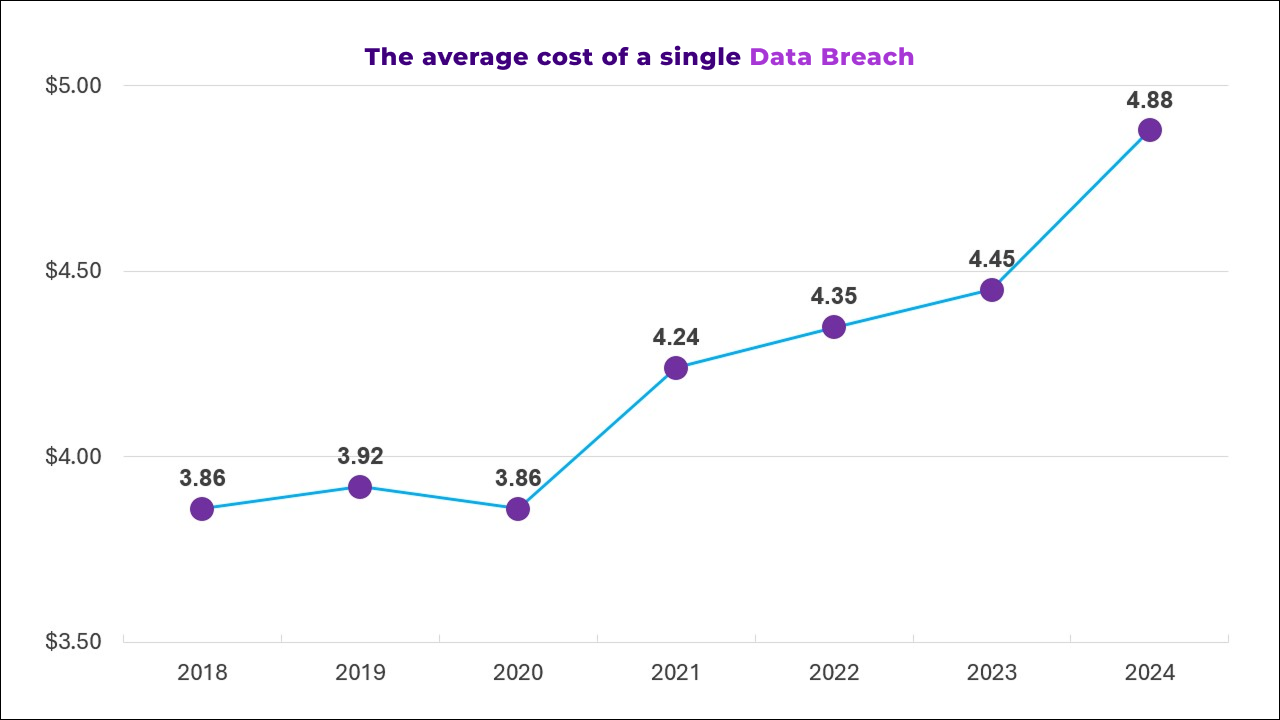Cybersecurity has evolved from a purely technical concern to a strategic pillar for businesses in recent years. However, the growing talent shortage in this field jeopardizes organizations' ability to protect themselves against increasingly sophisticated threats. According to a report by the World Economic Forum, 67% of organizations report a moderate-to-critical skills gap in cybersecurity. The cybersecurity talent shortage in the United States exceeds 450,000 vacancies, according to CyberSeek data. Also, a global shortage of more than 4 million cyber professionals is estimated. This means that despite current efforts, the talent supply remains far below demand.
The lack of specialists not only slows response times to security incidents but also increases the costs associated with cyberattacks. According to IBM’s "Cost of a Data Breach Report 2024," the average cost of a data breach has hit a record high of $4.98 million. Alarmingly, companies with understaffed security teams experience longer response times and, consequently, greater financial and reputational losses. The costs are even higher in the United States, averaging $9.48 million per incident, making it the country with the highest breach-related losses.
Cyber skills shortage increases breach costs
Recent studies highlight a clear link between the shortage of skilled cybersecurity professionals and the rising cost of data breaches. In 2024, organizations facing significant talent gaps saw the average cost of a breach climb to USD 5.74 million—up from USD 5.36 million in 2023, marking a 7.1% increase. Notably, this figure exceeds the global average breach cost by USD 860,000.
 Measured in USD millions | Source: Cost of a Data Breach Report 2024, IBM
Measured in USD millions | Source: Cost of a Data Breach Report 2024, IBM
 Measured in USD millions | Source: Cost of a Data Breach Report 2024, IBM.
Measured in USD millions | Source: Cost of a Data Breach Report 2024, IBM.
What Happens When There Aren’t Enough Defenders?
Organizations are reporting an increasing inability to respond to cyberattacks due to a lack of trained personnel. This is especially alarming in low-revenue organizations, where their capacity is increasingly diminishing.
 Measured in percentage | Source: Global Cybersecurity Outlook 2025, World Economic Forum.
Measured in percentage | Source: Global Cybersecurity Outlook 2025, World Economic Forum.
Why Is There a Cybersecurity Talent Shortage?
While the cybersecurity talent shortage is not a new issue, its rapid growth in recent years has caught the attention of business and government leaders. Several key factors explain this phenomenon:
Unprecedented Digital Acceleration: The massive adoption of cloud technologies, artificial intelligence, and automation has created new attack surfaces that require specialized protection.
Constant Evolution of Threats: The rise of advanced threats, such as ransomware and AI-driven attacks, demands highly specialized professionals who are not always readily available in the job market.
Educational Gap: The speed at which cyber threats evolve surpasses the ability of educational institutions to train professionals with the necessary skills.
High Turnover Rates: Intense competition for cybersecurity talent causes many companies to lose their specialists quickly, increasing infrastructure vulnerabilities.
Impact on Cloud Security and Regulatory Compliance
One of the sectors most affected by this shortage is cloud security. As businesses increasingly migrate their operations to cloud environments, the demand for security experts to manage these ecosystems has surged. However, the lack of skilled personnel has forced many organizations to rely on Managed Security Service Providers (MSSPs) to fill these gaps.
Additionally, meeting compliance requirements such as SOX, PCI-DSS, HIPAA and ISO/IEC 27001 has become increasingly complex for highly regulated industries like finance and healthcare. These frameworks demand continuous monitoring, regular audits, and rapid incident response—efforts that are difficult to sustain without the right expertise.
Strategies to Address the Cybersecurity Talent Crisis
Although the cybersecurity talent shortage is a complex issue, organizations can adopt several strategies to mitigate its impact:
Invest in Training and Certification: Prioritizing internal training programs, partnerships with universities, and certifications such as CISSP, CEH, or CompTIA Security+ can help develop in-house talent instead of relying solely on external hiring.
Leverage Automation and Artificial Intelligence: AI-driven tools can help reduce the workload on security teams by automating repetitive tasks such as log analysis and threat detection.
Outsource Security to Specialized Providers: Partnering with a Managed Security Service Provider (MSSP) allows companies to access advanced expertise without maintaining large in-house cybersecurity teams.
Promote Diversity in the Industry: Expanding access to cybersecurity careers for underrepresented groups, such as women and minorities, through scholarships, mentorships, and inclusion programs can help bridge the talent gap.
Retain Talent with Competitive Benefits: Offering attractive salaries, career growth opportunities, and a work environment that prioritizes employee well-being is crucial to reducing turnover and ensuring the stability of cybersecurity teams.
Cybersecurity is a strategic priority, especially in cloud environments and highly regulated sectors. A comprehensive approach is required to ensure operational continuity and the trust of customers and business partners.
In this context, the cybersecurity talent deficit represents a growing threat to the stability and security of businesses worldwide. However, by adopting proactive strategies such as investing in training, leveraging advanced technologies, and collaborating with specialized providers, organizations can strengthen their resilience against cyber threats.
Source
Global Cybersecurity Outlook 2025, World Economic Forum
Cybersecurity Supply/Demand Heat Map, Cyberseek
Cost of a Data Breach Report 2024, IBM
Credits
Writer: Ben Rodríguez
Editor: Luis Vinay
Technical reviewer: Gastón Valdés
Illustrator: Dai Fiorenza
Disclaimer
In this article, AI was used to check grammar and syntax.